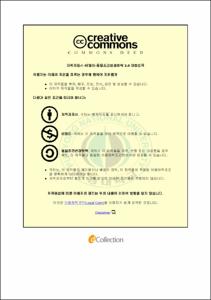LCD 칼라필터용 안료의 분산 및 나노화 공정에 관한 연구
- Alternative Title
- A study on Dispersion and Nanocrystallization Characteristics of LCD Colorfilter Pigment
- Abstract
- Phthalocyanine material has been widely used in many field of organic pigment, chemical sensor, electro-chromic display device, photovoltaic cell, xerography, optical disk, catalysis, non-linear optic, etc. Epsilon copper phthalocyanine (ε-CuPc) has a reddish hue, a high clearness and a high tinting strength as compared with other crystal forms of CuPc. Therefore, nano-sized ε-CuPc has been used as blue-component color filter in high quality liquid crystal display (LCD) panel due to its thermal stability and bright hue.
In this study, after ε-CuPc crude was synthesized by seed method from 1,2-dicyanonbenzene and copper chloride as starting materials, the crude was crushed and grounded by using ball-milling. To prevent the change of crystal form during the ball-milling, various phthalocyanine derivatives having different side group were added. Particle size, shape and crystalline structure were evaluated in the various milling condition such as milling speed, milling time, size and charge amount of bead, and kind of derivatives.
Finally, the possibility of its commercial use was found because ε-CuPc with the particle size of below 50 nm was fabricated successfully round shape in high stability.
Chemical structure was confirmed by utilizing infrared spectroscope. Particle size, shape and crystalline structure were compared and evaluated after particle size reductions by using transmission electron microscope (TEM) and X-ray diffractometer (XRD). Also the behavior of phase transformation of nano-sized ε-CuPc was investigated in various condition such as solvent and temperature. Finally, dipersion and thermal properties of samples were analyzed by particle size analyzer (PSA) and thermogravimetry analyzer (TGA), respectively.
Pigment yellow 154 (P.Y.154) is a benzimidazolone pigment which has been widely used in the fields of printing ink, plastics, color toner, and color filter, etc. It is a greenish to medium yellow shade pigment with excellent light fastness, heat resistance, solvent resistance, acid resistance and alkali resistance. In this study was synthesized by cold coupling reaction. After that, sample was grown at various solvents, dispersion derivatives and temperature to improve dispersion property by the use of autoclave. The size of particle, shape and crystalline structure were controled at reactions factors such as time, temperature, various solvents according to the polarity of the solvent.
- Issued Date
- 2012
- Awarded Date
- 2012. 2
- Type
- Dissertation
- Keyword
- LCD Colorfilter Pigment
- Publisher
- 부경대학교 대학원
- Alternative Author(s)
- Kim, Song Hyuk
- Affiliation
- 부경대학교
- Department
- 대학원 공업화학과
- Advisor
- 박성수
- Table Of Contents
- Contents
Contents.......................................................................................................................ⅰ
List of scheme.........................................................................................................ⅴ
List of Tables...........................................................................................................ⅵ
List of Figures..........................................................................................................ⅶ
Abstract.......................................................................................................................ⅻ
Chapter Ⅰ. ε상 CuPc의 합성 및 볼밀 공정을 통한 나노 최적화에 관한 연구
1. 서론..........................................................................................................................1
2. 이론적 배경..............................................................................................................3
2.1 안료.......................................................................................................................3
2.1.1 안료의 정의.....................................................................................................3
2.1.2 무기안료........................................................................................................3
2.1.3 유기안료........................................................................................................4
2.2 프탈로시아닌.......................................................................................................6
2.2.1 동프탈로시아닌..............................................................................................8
2.2.2 동프탈로시아닌의 결정상.............................................................................9
2.2.3 ε상 동프탈로시아닌.......................................................................................9
2.3 안료의 분산.....................................................................................................12
2.3.1 입체장애 효과............................................................................................14
2.3.1.1 분산제.....................................................................................................17
2.3.1.2 분산 유도체...........................................................................................19
2.3.2 표면처리......................................................................................................21
2.3.2.1 계면 활성제...........................................................................................24
2.4 나노 기술.........................................................................................................27
2.5 안료의 나노화.................................................................................................28
2.5.1 합성 공정에서의 나노화..........................................................................28
2.5.2 황산법..........................................................................................................29
2.5.3 볼밀..............................................................................................................30
2.5.4 비드밀..........................................................................................................33
2.5.5 솔트밀..........................................................................................................35
3. 실 험......................................................................................................................36
3.1 시약....................................................................................................................36
3.2 ε 결정상 동프탈로시아닌 crude의 합성..................................................37
3.3 분산제 합성.....................................................................................................39
3.3.1 SubPc의 합성............................................................................................39
3.3.2 NP-S의 합성..............................................................................................39
3.3.3 16ClCuPc의 합성.......................................................................................40
3.3.4 PC-OC의 합성...........................................................................................40
3.3.5 PC-SO4의 합성..........................................................................................41
3.3.6 PC-IMID의 합성.......................................................................................42
3.3.7 PC-COOH의 합성....................................................................................43
3.4 나노화 분산 공정...........................................................................................44
3.4.1 볼밀 공정....................................................................................................44
3.4.2 비드밀 공정................................................................................................45
3.4.3 하이브리드 공정........................................................................................46
3.5 측정 및 분석...................................................................................................47
3.5.1 FT-IR spectrometer................................................................................47
3.5.2 X-ray diffraction......................................................................................47
3.5.3 결정 크기....................................................................................................47
3.5.4 결장 순도....................................................................................................48
3.5.5 Transmission Electron Microscope.....................................................48
3.5.6 색상 Test....................................................................................................49
3.5.6.1 전색 Test...............................................................................................49
3.5.6.2 분광학적 측정 및 색차 측정............................................................49
3.5.7 열분석 ........................................................................................................49
4. 결과 및 고찰.......................................................................................................50
4.1 구조분석 .........................................................................................................50
4.2 용매별 특성 ...................................................................................................52
4.3 분산제별 특성.................................................................................................56
4.4 공정별 특성.....................................................................................................60
4.4.1 볼밀 공정....................................................................................................60
4.4.2 비드밀 공정................................................................................................63
4.4.3 하이브리드 공정........................................................................................65
4.5 색상 Test.........................................................................................................67
4.5.1 전색 측정....................................................................................................67
4.5.2 색도도 및 색조도 측정............................................................................70
4.5.2.1 용매별 특성...........................................................................................70
4.5.2.2 분산제별 특성.......................................................................................74
4.6 분광학적 특성.................................................................................................78
4.6.1 결정상별 특성............................................................................................79
4.6.2 용매별 특성................................................................................................81
4.6.3 분산제별 특성............................................................................................84
4.7 열적 특성.........................................................................................................89
4.7.1 결정상별 특성............................................................................................89
5. 결론........................................................................................................................91
참고문헌.....................................................................................................................92
Chapter Ⅱ. Benzimidazolone계 Pigment Yellow 154의 합성 및 Autoclave공정에 따른 결정성의 변화
1. 서론.......................................................................................................................95
2. 이론적 배경.........................................................................................................95
2.1 Azo계 유기안료.............................................................................................95
2.2 Pigment Yellow 154.....................................................................................96
2.3 디아조화(diazotization).................................................................................98
2.4 커플링 반응(Coupling reaction)...............................................................100
3. 실험......................................................................................................................101
3.1 시약..................................................................................................................101
3.2 Pigment Yellow 154의 합성.....................................................................101
3.2.1 2-(trifluoromethyl)aniline 디아조 수용액의 제조............................101
3.2.2 5-aminobenzoimidazolone 커플러 수용액의 제조..........................103
3.2.3 커플링 합성................................................................................................104
4. 측정 및 분석.....................................................................................................105
4.1 Yellow154의 조건별 실험..........................................................................110
4.1.1 디아조 첨가량의 영향............................................................................110
4.1.2 pH의 영향...............................................................................................114
4.1.3 Autoclave공정시 용매의 영향.............................................................117
5. 결론......................................................................................................................127
참고문헌...................................................................................................................128
Chapter Ⅲ. 총괄 결론...................................................................129
- Degree
- Master
- Files in This Item:
-
-
Download
 LCD 칼라필터용 안료의 분산 및 나노화 공정에 관한 연구.pdf
기타 데이터 / 4.78 MB / Adobe PDF
LCD 칼라필터용 안료의 분산 및 나노화 공정에 관한 연구.pdf
기타 데이터 / 4.78 MB / Adobe PDF
-
Items in Repository are protected by copyright, with all rights reserved, unless otherwise indicated.